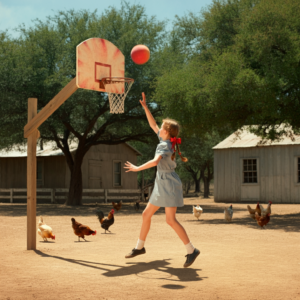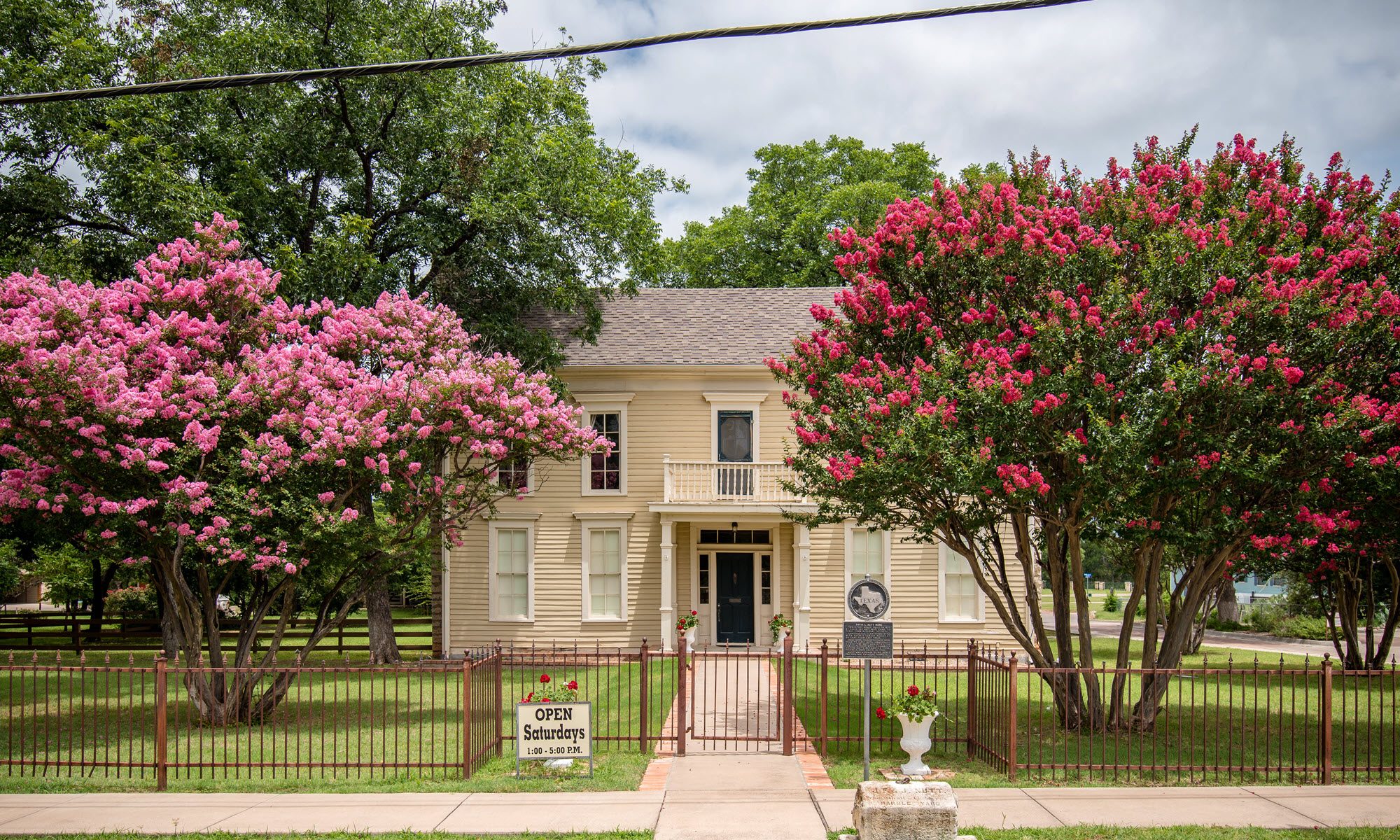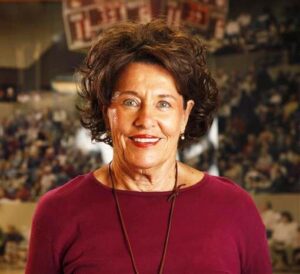Leta Andrews Biographical Sketch:
Listen to the podcast summary of Leta Andrews career below:
Just mention sports in Hood County and the name Leta Mae Rains Andrews will come up immediately. Leta holds the honor of being the winningest coach in high school basketball history, with an incredible 1,416 victories under her belt. Over her 52-year coaching career, she became an icon in women’s basketball, eventually elected to six different Halls of Fame.
Coach Andrews was born near Granbury in 1937 and was a basketball star with the Lady Pirates, teaming with her sister, Shirley, to lead their team to two consecutive state championship games. Interestingly, Leta was the first player ever to make the all-state team as both a forward and a guard, this being back in the days of 6-person half-court basketball for girls. She also passed the basketball genes down to her three daughters, all of who were all-state players under Coach Andrews, then played college ball for the famed Jody Conradt at the University of Texas. Her husband, David, was an avid supporter through their 62 years of marriage. Despite the full-time schedule of being an educator himself (teacher, coach, administrator), he rarely missed a game. As her career developed, Leta had quite a resume of Texas coaching jobs, having stays in Tolar, Gustine, Comanche, Corpus Christi, and of course, Granbury (twice!). Coach Andrews finally decided to retire from coaching in 2014, but she left behind a legacy of hundreds of young ladies she drilled in the fundamentals of basketball, winning, and life. In 2017, she was honored with a documentary film, “It’s All In The Game: The Leta Andrews Story,” about her life and accomplishments. The film is narrated by the great Bill Walton, who played for John Wooden at UCLA. Coach Wooden was a close friend and mentor to Leta Andrews, and she refers to him often. She also likes to say that her most significant accomplishment was getting young ladies to believe in themselves, which led not only to basketball victories, but success in life. Her legion of fans could list many other achievements, such as her remarkable streak of 34 consecutive years with over 20 wins each season!
Dr. Tom Hamilton
March 2021
Leta Andrews Interview
Listen To Tom Hamilton Interview Leta Andrews (.mp3).
Title: Oral History Interview with Leta Andrews
Date: May 3, 2021
interviewer: Dr. Tom Hamilton, Bridge Street History Center
Tom Hamilton: Good morning. This is May 3rd, 2021. I’m Dr. Tom Hamilton with the Bridge Street History Center, and I’m here at Coach Leta Andrews’ home outside of Granbury. She has kindly agreed to give us an interview for our oral history series. Thank you so much for participating today, Coach Andrews.
Leta Andrews: Thank you, Tom. I’m very pleased to work with you and see what memories we can bring to the surface.
Tom Hamilton: Fantastic. Let’s get started. Could you begin with your birth year and some of your family history?
Leta Andrews: I was born on July 2nd, 1937, at our family home in the countryside near Granbury. My parents had four children, and I was the second child. I had one sister and two brothers. Life was pretty tough back then because we were farmers and ranchers. We’d get up early to work, then catch a bus to go to Granbury schools.
Tom Hamilton: Could you tell us about your early life on the farm and how you got started in basketball?
Leta Andrews: We worked about 2000 acres, getting up early to work until it was time to catch the bus for school. That experience of working from sunup to sundown was a great incentive for me to go to college and get a degree in teaching and kinesiology so I could work with basketball. My father wanted us to play basketball, but he couldn’t quite understand why we needed to practice. He put up a goal for us, but it was in the chicken pen. None of us children wanted the ball to land on the ground for obvious reasons. It made us all really good rebounders and hustlers. I think that’s when I dreamed of being a basketball player in Granbury, Texas.

Tom Hamilton: That must have put a lot of emphasis on good passing rather than dribbling.
Leta Andrews: Absolutely. It’s funny you mention that because in my 52 years of coaching, my teams never used a bounce pass. I learned from John Wooden of UCLA that it’s a slow pass and would likely get taken away. He taught me to get the ball shuttled to the person quickly.
Tom Hamilton: Coach, even though you grew up on the farm, I’m sure you spent time in downtown Granbury. Can you share some memories of what the square was like compared to now?
Leta Andrews: We would go to Granbury probably once a week, on Saturday, to get groceries. There might have been 10 or 12 cars around the square at that time. People didn’t come to town much; they were usually working on their farms and ranches.Granbury has always been a neat little place. I’ll never forget the night they brought the Bonnie and Clyde car to the square. We went to see it, and I’d never seen so many bullet holes in a vehicle. I think my father was trying to teach us a lesson about the consequences of doing wrong things.
The square hasn’t changed much today, but back in the early ’40s, you wouldn’t see many cars. We had the movie theater, which was a good treat. We paid 10 cents to go to the movies, which was a lot of money then.
Tom Hamilton: How much was popcorn?
Leta Andrews: We weren’t allowed to get popcorn. We didn’t have the extra money. But I saw they had a little sign that said 5 cents a sack.
Tom Hamilton: You mentioned going to Granbury schools. Do you have any stories from your early basketball days there?
Leta Andrews: It was a dream to be playing and being part of a team. When we first started, we only had an outside court. If it rained, we couldn’t play. But when Decker Gym was built, that place became like the queen of Granbury. I got to play in the gym all four years of high school.

My coach, Don Smith, was also the principal. We played the six-player game with three guards on one end and three forwards on the other. I played both positions at times, depending on if one of the girls was sick.
Tom Hamilton: If I remember correctly, you’re one of the very few, if not the only person, to have made all-state in high school as both a guard and a forward back in the half-court days.
Leta Andrews: That’s true. It’s quite an honor. What happened was, when we won the regional championship and qualified for the state tournament in Austin, one of our good players didn’t ride the bus back home. Mr. Smith kicked her off the team, so I played guard the first year we were in Austin. The next year, I played forward.
Tom Hamilton: That’s quite a story. So from Granbury High, you went to college on a scholarship?
Leta Andrews: I went to Weatherford College and played basketball there. The rules then allowed one or two girls to go from baseline to baseline, and I always got to do that. I wanted that ball in my hand.
When we transitioned to the five-player game, I initially fought to keep what we had because I thought we had a unique game. But many young people coming into coaching wanted it changed. I thought the rich just got richer and the poor got poorer, but it’s still about basics, fundamentals, and teaching the skills of the game.
Tom Hamilton: Where did you go after Weatherford College?
Leta Andrews: I went to Texas Wesleyan in Fort Worth, where I got my undergraduate degree in English and kinesiology. Initially, I got an elementary teaching certificate and did my internship, but I quickly realized it wasn’t for me. I told my husband, David, who was getting his master’s degree, that I couldn’t teach elementary school for the rest of my life.
I then got my secondary teaching certificate in English and kinesiology. My first job was at Tolar, Texas, where I taught English and coached women’s basketball. I thought I’d died and gone to heaven. David finished his degree, and then we went together to Gustine, Texas, where we both worked.
Tom Hamilton: How long did you stay in Gustine?
Leta Andrews: We stayed two years in Gustine, then we went to Comanche for 12 years.
Tom Hamilton: And you established quite a record in Comanche.
Leta Andrews: Yes, we had a pretty good record in Comanche. We went to the Final Four a number of times, and by then my daughters were playing. We could never win that final game, though. We’d lose by one point or in overtime. It was hard. I wanted my daughters to taste a state championship because they played hard, along with all their teammates.
Tom Hamilton: Let’s backtrack for a moment. You and Dave were married for a long time. How did you meet?
Leta Andrews: We met in the halls of Granbury High School. One day, as we were changing classes, he called out, “Leta, do you want to go to North Side Coliseum Saturday night with me to see Elvis Presley?” I said, “Who’s Elvis Presley?” He said, “Well, you’ll find out if you’ll go.” So I went. Oh my, I had never seen anything like it. It was quite a show. This was in 1953.
Tom Hamilton: Wow, you got to see one of Elvis’s early, early shows.
Leta Andrews: Yes, and later we went to see him in Abilene. He was quite an entertainer, one of the best. Tom Hamilton: So you coached in Comanche for 12 years, and then you left there to come to Granbury?
Leta Andrews: Yes, we came to Granbury because David got an offer to be the tax assessor collector. It paid much more. I continued teaching and coaching. But after about two years, David realized he missed working with kids and decided to go back to education.
We then took jobs in Corpus Christi Calallen and stayed there for 12 years. The base pay was unbelievable due to the petrochemical plants. We thought we’d get our salaries up to have a comfortable retirement income. That’s where we won the state championship in 1990.
Tom Hamilton: Why did you decide to come back to Granbury to finish your coaching career?
Leta Andrews: We came back because our parents were getting older and needed help. On our way home, I got a call from the Granbury superintendent, James Wann, saying they needed a girls’ basketball coach. After some consideration, I took the job.
Tom Hamilton: You’ve been very successful in your life. Could you name a few of the most influential people in your life?
Leta Andrews: Well, my father was one strong influence. Then I’d have to say my husband, David. The third would be John Wooden of UCLA.
Tom Hamilton: How did you ever get to know John Wooden?
Leta Andrews: In 1992, I was elected the Walt Disney Teacher of the Year, and he was elected the honorary teacher of the year. We had to work for Walt Disney for a year, traveling and doing programs together. He’d fly out of Los Angeles, I’d fly out of DFW, and we’d meet to do programs. All the time we were together, he was teaching me basketball.
Tom Hamilton: That must have been fascinating. What’s the greatest honor or award that you have received thus far? Leta Andrews: It would be the Walt Disney Teacher of the Year award.
Tom Hamilton: Lastly, of all your many accomplishments, which made you most proud?
Leta Andrews: You know, I was proud to be a part of every group of young ladies I coached. They were the sweetest, hardest-working young women, including your daughter, Whitney. They gave me all they could give and never left anything on the court. They’d do whatever was asked of them without question.
Tom Hamilton: I know Whitney always said that you taught life lessons as much as you did basketball lessons.
Leta Andrews: She was a sweetie pie and a hard player, as they all were. I’ll never forget one night there was a loose ball going out of bounds, and she made a dive for it. Somehow, she got up with it without traveling. She was so quick, as were many of my players. They all played their hearts out.
Tom Hamilton: They certainly did. Well, coach, I can’t tell you how much of a pleasure this has been. Thank you once again.
Leta Andrews: Thank you, Tom.
Tom Hamilton: My pleasure.
Additional Information:

